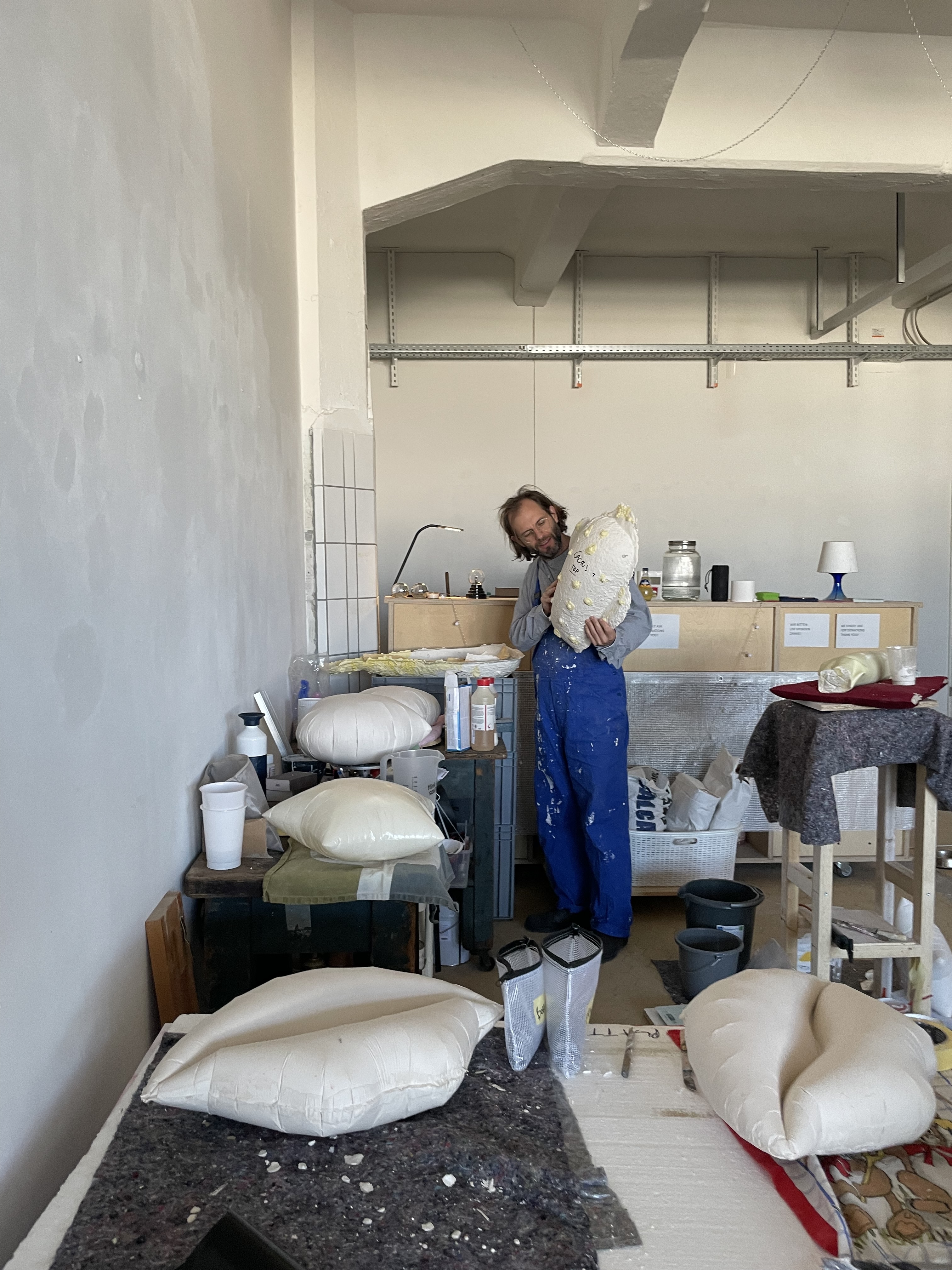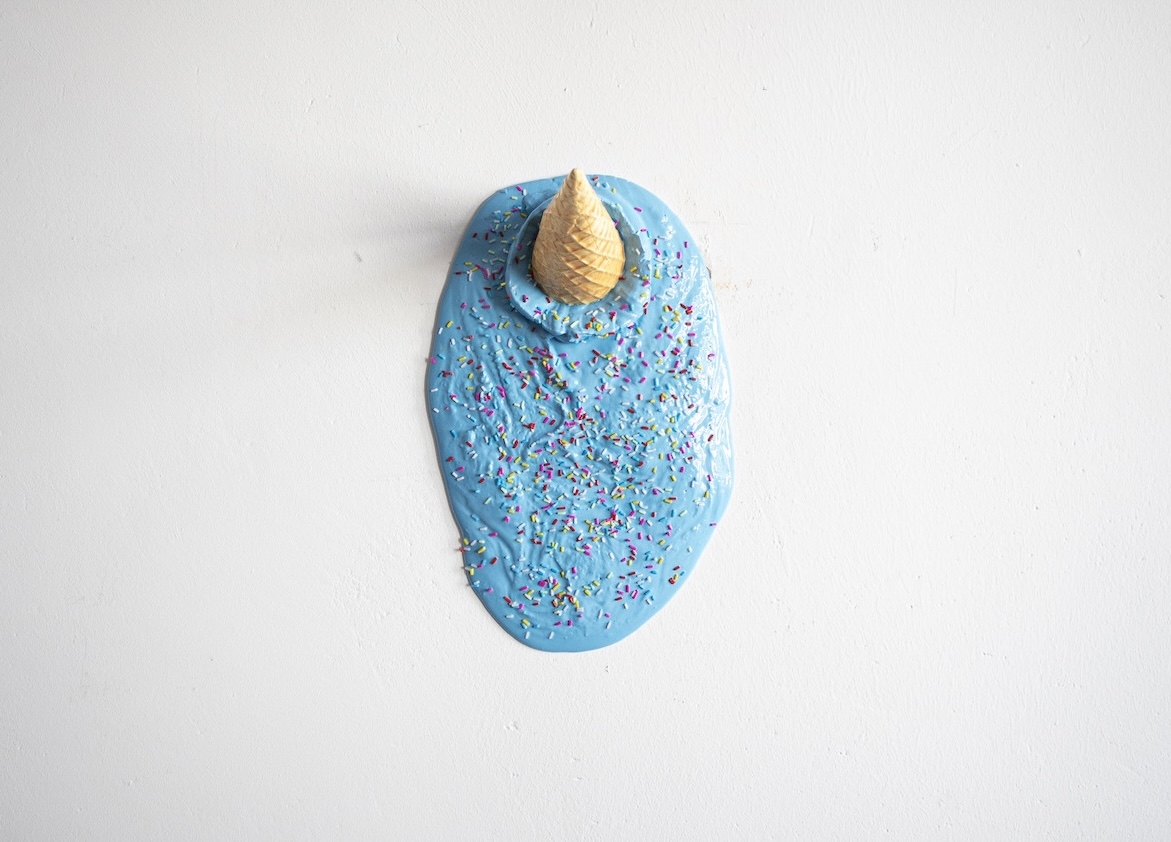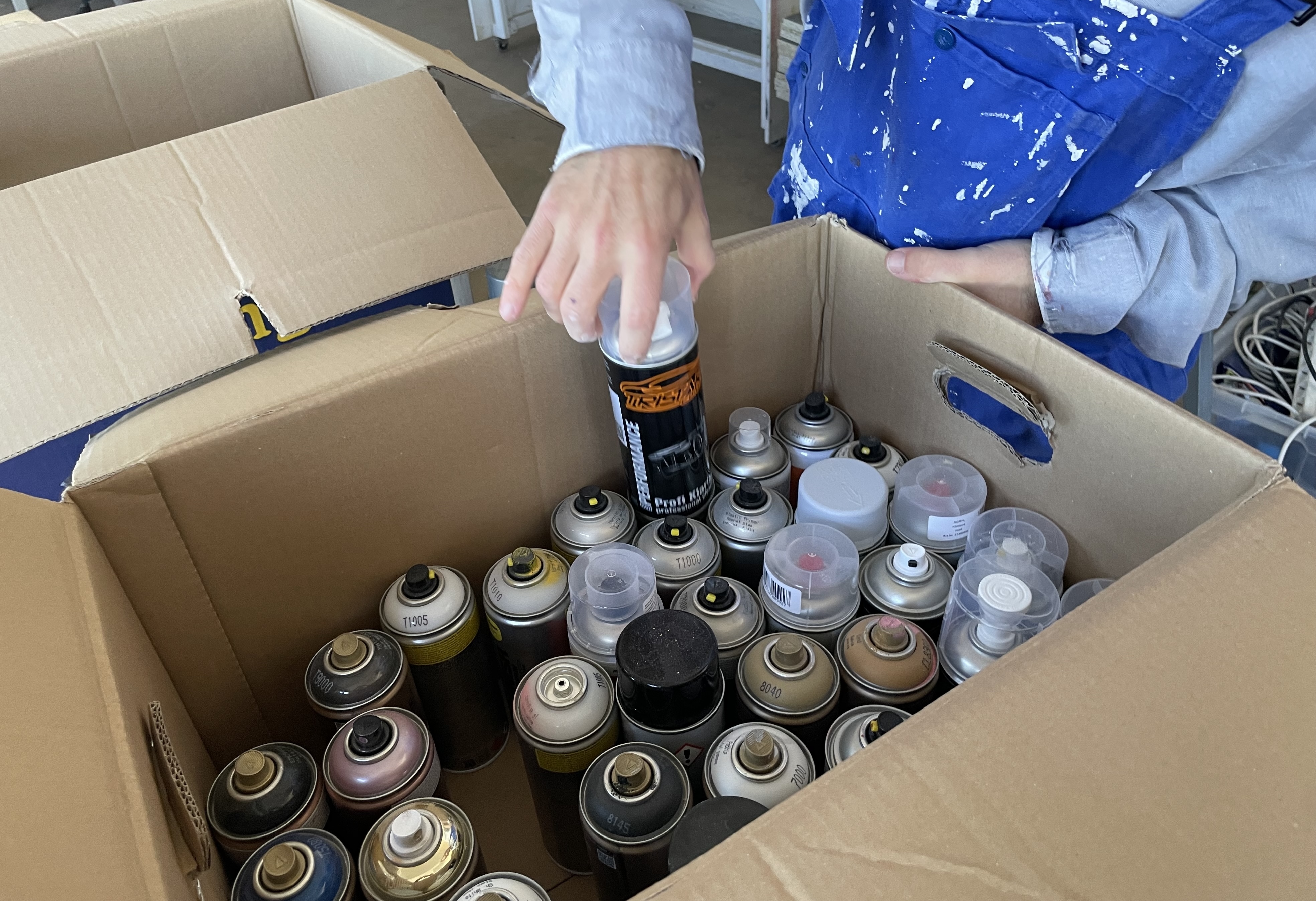Phillip Staffa: Joy, Play, and the Shape of Everyday Life

EN: Berlin-based artist and musician Phillip Staffa moves fluidly between sound and form, exploring how emotion, color, and playfulness intertwine in the creative act. Known for his sculptural works that transform ordinary moments – such as fallen ice cream cones or oversized candy – into poetic meditations on joy and perception, Staffa approaches art as a way of reconnecting with spontaneity and the tactile world.
For Staffa, both music and visual art have always coexisted. “I’ve always done both,” he reflects. “As a teenager I played music and made art at the same time.” Yet for many years, music took precedence. Touring and performing with bands such as Depeche Mode filled his creative life until, during the quiet isolation of the COVID years, he rediscovered his desire for something he could shape with his hands. “In music you can’t touch the form, it doesn’t exist in space,” he says. “I missed that.” Picking up sculpture again became a return to something essential, something physical, almost instinctive.
His artistic process is grounded in curiosity and openness. Beginning with a spontaneous moment of inspiration that hits him, Staffa lets intuition guide him. “I try not to have a plan,” he explains. He often works on many pieces at once, ten or twenty simultaneously at varying stages, discarding much along the way. Selection is as much a part of his process as creation. The decision to stop working on a piece arrives unexpectedly: “There’s a moment when I am working on it and don’t want to change anything anymore. I stop thinking, and start simply looking at it, and then I know it’s done.”
Staffa’s series of ice cream sculptures began as a simple impulse toward joy. “I wanted to make something that felt light and not dystopian,” he says. The idea grew from photos he and a friend took of fallen ice creams around Neukölln. These accidental moments became the foundation for playful plaster sculptures that celebrate the overlooked beauty in everyday life.

For him, the ice cream motif is both literal and symbolic. “Everyone knows what an ice cream is, what it looks like,” he notes. “It’s universal, everyone has a memory connected to it.” By transforming something familiar into an object of contemplation, Staffa invites viewers to see the world differently. He finds beauty in the unnoticed: “What interests me are the forms we normally overlook—the geometry, the subtlety. They’re there every day, but we don’t see them.” The result is a body of work that feels both familiar and surreal, rooted in the tactile yet emotionally expansive.
Joy, optimism, and play are central to his work, but not naïve. They are deliberate choices, a way of countering darker tendencies both in art and in life. “I try to give optimism more space,” he says. “Both sides exist, but if I can choose where to put my energy, I choose the positive.” This philosophy shapes not only his bright, candy-colored works but also the spirit with which he approaches them.
Staffa describes his creative process as a dialogue between concept and instinct. While his early works all included a sound element, his more recent practice emphasizes color, texture, and material. Whether working in plaster, paint, or fabric, the material is secondary to the process of creative discovery. This sense of wonder and openness lies at the heart of his practice. His work, whether made of plaster, color, or cloth, seeks to hold on to that fleeting moment when curiosity becomes creation. The result is an art that feels alive, immediate, and emotionally resonant.
For Staffa, creativity is inseparable from play. “When I make art, I sometimes feel like I’m ten years old again,” he admits. “I sit there making colorful things and listening to music. It’s the same joy.” That return to childhood, the unselfconscious, open, and curious, which lies at the heart of his practice. Through color, form, and humor, his work reminds us of the simple delight of noticing the world, of letting it surprise us again. They remind viewers of the simple joys often lost in the mire of routines and responsibilities of adult life.
At its core, Phillip Staffa’s art is an act of optimism. It honors small moments and familiar shapes not as trivial details but as sources of wonder. His sculptures and paintings invite a reawakening of attention—a reminder that joy, like art, begins with seeing.

DE: Der in Berlin lebende Künstler und Musiker Phillip Staffa bewegt sich mühelos zwischen Klang und Form und erforscht, wie Emotion, Farbe und Verspieltheit im kreativen Prozess ineinandergreifen. Bekannt für seine Skulpturen, die alltägliche Momente – wie herabgefallene Eiswaffeln oder überdimensionale Bonbons – in poetische Meditationen über Freude und Wahrnehmung verwandeln, versteht Staffa Kunst als eine Möglichkeit, sich mit Spontaneität und der haptischen Welt wieder zu verbinden.
Für Staffa existieren Musik und bildende Kunst schon immer nebeneinander. „Ich habe immer beides gemacht“, erinnert er sich. „Als Teenager habe ich gleichzeitig Musik gemacht und Kunst geschaffen.“ Über viele Jahre stand jedoch die Musik im Vordergrund. Tourneen und Auftritte, unter anderem mit Bands wie Depeche Mode, füllten sein kreatives Leben aus. Während der stillen Isolation der COVID-Jahre entdeckte er dann die Sehnsucht nach etwas, das er mit den Händen formen konnte, wieder. „In der Musik kann man die Form nicht berühren, sie existiert nicht im Raum“, sagt er. „Das habe ich vermisst.“ Die Rückkehr zur Skulptur war für ihn ein Weg zurück zu etwas Essentiellem, etwas Körperlichem, fast Instinktivem.
Sein künstlerischer Prozess ist geprägt von Neugier und Offenheit. Ausgangspunkt ist oft ein spontaner Moment der Inspiration, dem Staffa intuitiv folgt. „Ich versuche, keinen Plan zu haben“, erklärt er. Häufig arbeitet er an vielen Werken gleichzeitig – zehn oder zwanzig in verschiedenen Stadien – und verwirft dabei vieles. Auswahl ist für ihn ebenso Teil des Prozesses wie das eigentliche Schaffen. Der Moment, in dem er aufhört, an einem Werk zu arbeiten, kommt unerwartet: „Es gibt diesen Punkt, an dem ich nichts mehr verändern will. Ich höre auf zu denken, betrachte es nur noch – und dann weiß ich, es ist fertig.“
Staffas Serie der Eiscreme-Skulpturen begann aus einem einfachen Impuls der Freude. „Ich wollte etwas machen, das sich leicht anfühlt und nicht dystopisch“, erzählt er. Die Idee entstand aus Fotos, die er gemeinsam mit einer Freundin von heruntergefallenen Eiswaffeln in Neukölln machte. Diese zufälligen Alltagsmomente wurden zur Grundlage für verspielte Gipsobjekte, die die übersehene Schönheit des Alltäglichen feiern.
Für ihn ist das Eis zugleich wörtlich und symbolisch. „Jeder weiß, was ein Eis ist, wie es aussieht“, bemerkt er. „Es ist etwas Universelles, jeder verbindet Erinnerungen damit.“ Indem er etwas Vertrautes in ein Objekt der Betrachtung verwandelt, lädt Staffa das Publikum ein, die Welt anders zu sehen. „Mich interessieren die Formen, die wir normalerweise übersehen – die Geometrie, die Feinheit. Sie sind jeden Tag da, aber wir sehen sie nicht.“ So entsteht ein Werk, das zugleich vertraut und surreal wirkt, in der Materialität verankert und doch emotional weit geöffnet.
Freude, Optimismus und Spiel sind zentrale Themen seiner Arbeit, aber nicht im naiven Sinne. Es sind bewusste Entscheidungen – ein Gegengewicht zu den dunkleren Tendenzen in Kunst und Leben. „Ich versuche, dem Optimismus mehr Raum zu geben“, sagt er. „Beide Seiten existieren, aber wenn ich entscheiden kann, wohin ich meine Energie lenke, dann wähle ich das Positive.“ Diese Haltung prägt nicht nur seine leuchtend bunten Arbeiten, sondern auch die Haltung, mit der er ihnen begegnet.
Staffa beschreibt seinen kreativen Prozess als einen Dialog zwischen Konzept und Instinkt. Während seine frühen Arbeiten stets eine Klangkomponente enthielten, liegt der Fokus seiner jüngeren Praxis stärker auf Farbe, Textur und Material. Ob er mit Gips, Farbe oder Stoff arbeitet – das Material ist für ihn zweitrangig gegenüber dem Prozess des Entdeckens. Dieses Staunen und die Offenheit bilden das Herz seiner künstlerischen Arbeit. Seine Werke, ob aus Gips, Farbe oder Stoff, halten jenen flüchtigen Moment fest, in dem Neugier zu schöpferischem Ausdruck wird. Das Ergebnis ist eine Kunst, die lebendig, unmittelbar und emotional spürbar ist.
Für Staffa ist Kreativität untrennbar mit Spiel verbunden. „Wenn ich Kunst mache, fühle ich mich manchmal wieder wie zehn Jahre alt“, gesteht er. „Ich sitze da, mache bunte Dinge und höre Musik. Es ist dieselbe Freude.“ Diese Rückkehr in die Kindheit – unbefangen, offen und neugierig – bildet den Kern seiner Arbeit. Durch Farbe, Form und Humor erinnert seine Kunst an das einfache Vergnügen, die Welt wahrzunehmen und sich von ihr überraschen zu lassen. Seine Werke erinnern daran, dass die einfachen Freuden des Lebens oft im Alltag verloren gehen.
Im Kern ist Phillip Staffas Kunst ein Akt des Optimismus. Sie ehrt kleine Momente und vertraute Formen nicht als Nebensächlichkeiten, sondern als Quellen des Staunens. Seine Skulpturen und Gemälde laden zu einer neuen Aufmerksamkeit ein – zu der Erkenntnis, dass Freude, wie Kunst, mit dem Sehen beginnt.
Title Photo by Giulia Facciolo @giulia_facciolo
Get in Touch.
Want to either apply to the gallery, recommend an artist or simply ask some questions? Feel free to send a message. We’ll be more than happy to assist.
Follow Us on Instagram



